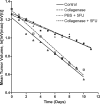Imaging intratumoral convection: pressure-dependent enhancement in chemotherapeutic delivery to solid tumors
- PMID: 19118052
- PMCID: PMC4217124
- DOI: 10.1158/1078-0432.CCR-08-0611
Imaging intratumoral convection: pressure-dependent enhancement in chemotherapeutic delivery to solid tumors
Abstract
Purpose: Low-molecular weight (LMW) chemotherapeutics are believed to reach tumors through diffusion across capillary beds as well as membrane transporters. Unexpectedly, the delivery of these agents seems to be augmented by reductions in tumor interstitial fluid pressure, an effect typically associated with high-molecular weight molecules that reach tumors principally through convection. We investigated the hypothesis that improved intratumoral convection can alter tumor metabolism and enhance the delivery of a LMW chemotherapeutic agent to solid tumors.
Experimental design: For this purpose, we applied 31P/19F magnetic resonance spectroscopy (MRS) and magnetic resonance spectroscopic imaging (MRSI) to examine the influence of type I collagenase on tumor bioenergetics and the delivery of 5-fluorouracil (5FU) to HT29 human colorectal tumors grown s.c. in mice.
Results: Collagenase effected a 34% reduction in tumor interstitial fluid pressure with an attendant disintegration of intratumoral collagen. Neither mice-administered collagenase nor controls receiving PBS showed changes in (31)phosphorus MRS-measured tumor bioenergetics; however, a time-dependent increase in the content of extracellular inorganic phosphate (Pi(e)) was observed in tumors of collagenase-treated animals. (31)Phosphorus MRSI showed that this increase underscored a more homogeneous distribution of Pi(e) in tumors of experimental mice. (19)Fluorine MRS showed that these changes were associated with a 50% increase in 5FU uptake in tumors of experimental versus control animals; however, this increase resulted in an increase in 5FU catabolites rather than fluoronucleotide intermediates that are required for subsequent cytotoxicity.
Conclusions: These data indicate that the modulation of convective flow within tumors can improve the delivery of (LMW) chemotherapeutics and show the potential role for noninvasive imaging of this process in vivo.
Figures






Similar articles
-
Multinuclear MR investigation of the metabolic response of the murine RIF-1 tumor to 5-fluorouracil chemotherapy.Magn Reson Med. 1991 Jun;19(2):373-85. doi: 10.1002/mrm.1910190228. Magn Reson Med. 1991. PMID: 1908937
-
Investigating Low-Velocity Fluid Flow in Tumors with Convection-MRI.Cancer Res. 2018 Apr 1;78(7):1859-1872. doi: 10.1158/0008-5472.CAN-17-1546. Epub 2018 Jan 9. Cancer Res. 2018. PMID: 29317434 Free PMC article.
-
Digesting a Path Forward: The Utility of Collagenase Tumor Treatment for Improved Drug Delivery.Mol Pharm. 2018 Jun 4;15(6):2069-2083. doi: 10.1021/acs.molpharmaceut.8b00319. Epub 2018 May 16. Mol Pharm. 2018. PMID: 29767984 Free PMC article. Review.
-
Non-invasive imaging of barriers to drug delivery in tumors.Microvasc Res. 2008 Aug;76(2):94-103. doi: 10.1016/j.mvr.2008.06.002. Epub 2008 Jun 27. Microvasc Res. 2008. PMID: 18638494 Free PMC article.
-
Phospholipid and energy metabolism of cancer cells monitored by 31P magnetic resonance spectroscopy: possible clinical significance.Mayo Clin Proc. 1988 Dec;63(12):1199-207. doi: 10.1016/s0025-6196(12)65406-8. Mayo Clin Proc. 1988. PMID: 3059078 Review.
Cited by
-
Increasing tumoral 5-fluorouracil concentrations during a 5-day continuous infusion: a microdialysis study.Cancer Chemother Pharmacol. 2011 May;67(5):1055-62. doi: 10.1007/s00280-010-1400-3. Epub 2010 Jul 23. Cancer Chemother Pharmacol. 2011. PMID: 20652702 Free PMC article. Clinical Trial.
-
Separation of Solid Stress From Interstitial Fluid Pressure in Pancreas Cancer Correlates With Collagen Area Fraction.J Biomech Eng. 2017 Jun 1;139(6):0610021-8. doi: 10.1115/1.4036392. J Biomech Eng. 2017. PMID: 28388715 Free PMC article.
-
Intravoxel incoherent motion diffusion-weighted imaging for early assessment of combined anti-angiogenic/chemotherapy for colorectal cancer liver metastases.Quant Imaging Med Surg. 2022 Sep;12(9):4587-4600. doi: 10.21037/qims-21-1220. Quant Imaging Med Surg. 2022. PMID: 36060592 Free PMC article.
-
Overview of Methods for Overcoming Hindrance to Drug Delivery to Tumors, with Special Attention to Tumor Interstitial Fluid.Front Oncol. 2015 Jul 23;5:165. doi: 10.3389/fonc.2015.00165. eCollection 2015. Front Oncol. 2015. PMID: 26258072 Free PMC article. Review.
-
Phenomenological model of interstitial fluid pressure in a solid tumor.Phys Rev E Stat Nonlin Soft Matter Phys. 2011 Aug;84(2 Pt 1):021919. doi: 10.1103/PhysRevE.84.021919. Epub 2011 Aug 15. Phys Rev E Stat Nonlin Soft Matter Phys. 2011. PMID: 21929031 Free PMC article.
References
-
- Jain RK. The next frontier of molecular medicine: delivery of therapeutics. Nat Med. 1998;4:655–7. - PubMed
-
- Jain RK. Delivery of molecular and cellular medicine to solid tumors. Adv Drug Deliv Rev. 2001;46:149–68. - PubMed
-
- Jain RK. Transport of molecules in the tumor interstitium: a review. Cancer Res. 1987;47:3039–51. - PubMed
-
- Heldin CH, Rubin K, Pietras K, Ostman A. High interstitial fluid pressure - an obstacle in cancer therapy. Nat Rev Cancer. 2004;4:806–13. - PubMed
-
- Swabb EA, Wei J, Gullino PM. Diffusion and convection in normal and neoplastic tissues. Cancer Res. 1974;34:2814–22. - PubMed
Publication types
MeSH terms
Substances
Grants and funding
LinkOut - more resources
Full Text Sources
Other Literature Sources
Medical
Research Materials
Miscellaneous

